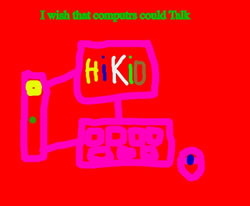
There might be a reason why the iPad is so popular with young children: It’s intuitive, touchable, and an extension of oneself—features that, according to a new survey, young children are asking for.
According to the study, titled “Children’s Future Requests for Computers & the Internet,” kids ages 12 and under are predicting that the future of media and technology lies in better integrating digital experiences with real-world places and activities.
They’re also suggesting that more intuitive, human-like interactions with devices, such as those provided by fluid interfaces or robots, are a key area for development.
The study, conducted by Latitudeº 42s, is part of an ongoing series of open innovation studies in which the company, an international research consultancy, publishes in the “spirit of knowledge-sharing and opportunity discovery for both established companies and emerging entrepreneurs.”
Latitude asked more than 200 kids from Argentina, Australia, Chile, Colombia, Denmark, India, Mexico, the Netherlands, Panama, South Africa, Spain, the United Kingdom, and the United States, “What would you like your computer or the internet to do that it can’t do right now?”

Parents also answered questions about their children’s technology use and their participation in various online activities, as well as basic demographic information.
The goal of the study was to “catch a glimpse into possible futures for technology as seen by digital natives, and to highlight actionable opportunities for new content, user experience, and technology offerings,” says the company.
Specifically, Latitude looked to answer three main questions:
- What does the next generation of digital natives expect and desire from technology, and how does this differ across world regions?
- How can we engage children as authors and inventors of future technology, not just passive recipients?
- How can young minds help companies develop unexpected content and technology experiences that resonate with people of all ages?
Researchers scored the kids’ drawings on the presence of specific technology themes, such as type of interface, degree of interactivity, physical-digital convergence, and user’s desired end-goal. (More about the methodology can be found in the study.)
“This study is part of our larger research initiative that gives children a real voice in the broader, often very adult, discussion of future technologies,” says Steve Mushkin, founder and president of Latitude, in a statement. “Across a variety of creative exercises, kids from all over the world have proven, time and again, that they think in extraordinarily sophisticated ways about how tech could enhance their learning, play, and interactions with the people and things around them—and the ways that technology might help us solve the big global problems we all face.”
From the drawings of babes
Overall, study participants imagined technologies that are just beginning to appear in tech-forward circles, says the study, such as Google’s revamped image search, announced on June 14, which allows users to place images, rather than text, in Google’s search box to perform a search.
Here are some other features of technology kids say they’d like to see:
- 3D effects
- Ability to teach/create—The internet can host classes, and computers can allow for game creation and other types of creation.
- Intuitive interface: verbal/auditory controls, human-level responses, and an idea of the device as merely an extension of oneself.
- No “online” and “offline” distinction—Technology is no longer something that mediates experience, but something that pervades it. For example, computers that print real food or that allow the user to touch objects on the screen.
- Social communication functions

“For many kids, the ‘online’ versus ‘offline’ and ‘virtual’ versus ‘real’ distinctions are quickly disappearing,” says Mushkin. “They naturally think about a future in which traditionally ‘online’ interactions make their way into the physical world, and vice versa—a concept already playing out in augmented reality, transmedia storytelling, the Internet of Things, and other recent tech developments.”
Perhaps even more interesting is how kids’ desires differ in different parts of the world.
For example, children in the U.S., Europe, and Australia have greater interest in the process of interactivity itself rather than any real-world outcomes, meaning more game-playing and conversing with the computer.
Children in Africa and South Asia, however, tended to focus on technologies with a clear outcomes or tangible benefit to the user, such as a “device that provides homework help, a software that assists the user in creating more true-to-life drawings, or a vehicle that helps one get from point A to point B quickly,” says the report.
Also, children in Africa, South Asia, and Latin America were more likely to anthropomorphize computers, or imagine them as friends or teachers that could share their experiences or help in the accomplishment of a goal.
According to the report, 74 percent of kids in those regions envisioned technologies that aided with real-world tasks or abilities, such as cleaning one’s room or learning ballet.

“Kids are asking for computers to look, feel, sound, act–and interact—more like humans,” says Jessica Reinis, a senior research analyst at Latitude who led the study and who specializes in creative methodologies for researching with children. “In many cases, it’s not enough to have a machine that simply completes a task for them; kids today have a strong bent towards independent learning, creation and artistic endeavors, and they’re looking for technologies that can teach them and really engage them in new ways.”
Where to go from here
According to Latitude, the idea of robots as teachers, software than teaches gaming creation, and activities online that can change the world aren’t so far-fetched.
For example, MIT’s Scratch is a programming language that allows kids to produce their own interactive content and games, and share their creations with others.
Also, sites like Nickelodeon’s “The Big Help” and Recyclebank assign real-world rewards for eco-friendly actions.
“Instant access to people, information and possibilities reinforces young users’ confidence and interest in self-development,” explains the study.
“One of the sweet spots we see clearly is content and game elements that flow seamlessly between screen space and physical space, and which have the ability to change the ‘real world’ for the better–for instance, online games that generate real currency to help solve societal problems or games that use social motivators and accountability to influence personal behaviors in health, energy use, and so on,” explains Mushkin.
Read Latitude’s blog posts discussing the findings of the study at the following links: http://www.latd.com/2011/06/14/study-kids-are-the-royal-road-to-tech-innovation/ and http://www.latd.com/2011/06/24/study-kids-say-the-future-of-tech-is-robots-real-world-integration/.
Latitude also just launched a new study in partnership with Project Synthesis and the LEGO Learning Institute called Robots@School, to further extend some of the present study’s findings.
Links:
“Children’s Future Requests for Computers & the Internet” (PDF)
Latitude’s Kids Innovation and Discovery Studies (KIDS)
- #4: 25 education trends for 2018 - December 26, 2018
- Video of the Week: Dealing with digital distraction in the classroom - February 23, 2018
- Secrets from the library lines: 5 ways schools can boost digital engagement - January 2, 2018


Comments are closed.